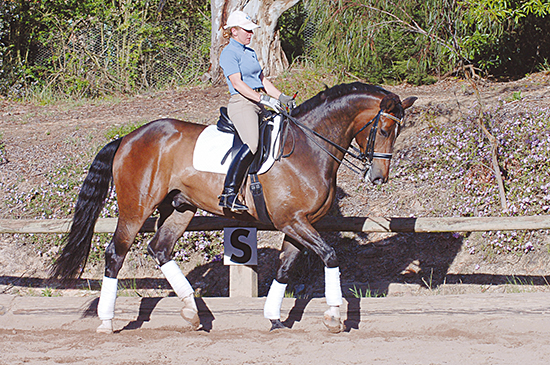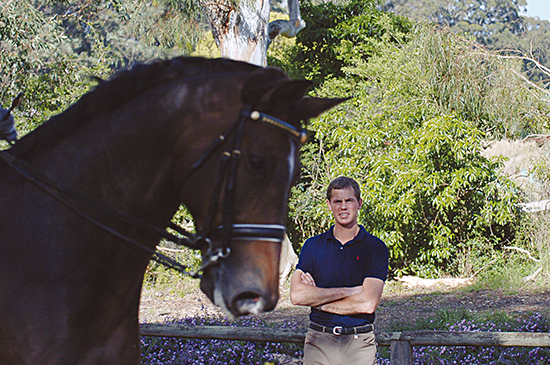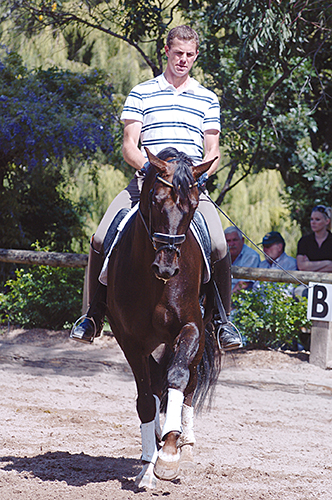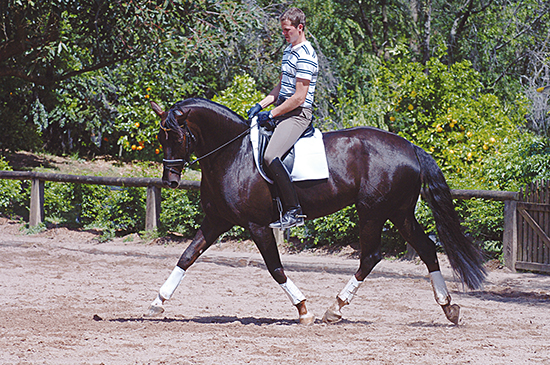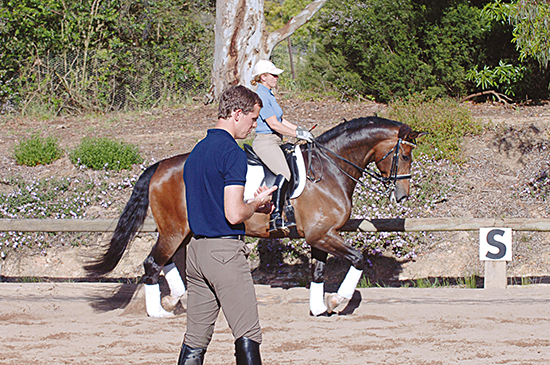 Story by Chris Hector and photos by Roz Neave
Story by Chris Hector and photos by Roz Neave
At last we are starting to see the products of frozen semen coming on line and one of the most exciting of those frozen youngsters is Ann Serrao’s big eight year old Weltmeyer son Weltsohn. But the gelding was proving a handful, even for the experienced FEI rider, as he spooked his way around the unfamiliar arena.
Stefan has a number of important messages, but none more important than the doctrine of making it easy for both horse and rider…
“To try to bring him a little more into self carriage, you have to let the tension out – you have to find the easiest way to make the horse trust you and put his excitability to work instead of jumping around.”
“Put him a little more in front of your legs so you can drive him through so that he stays on your aids. A little more up and allow the power from behind to flow through the legs and hands so it really can arrive at the bit.”
“The movement must go through the whole body. Where there is an interruption, if there is a blockage in the neck, or in the shoulder, get that out so that you can ride the half halt with no interruption. Ride smaller half halts so there is no interruption in the bending of the hindlegs and the swinging of the back.”
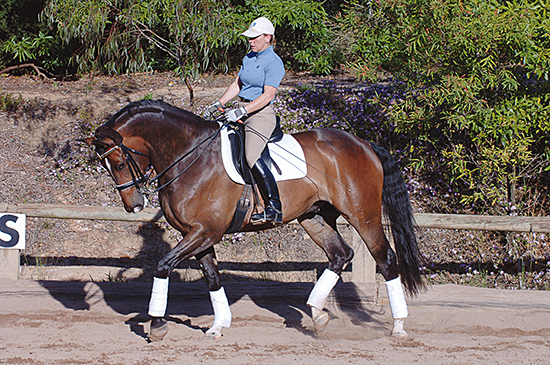 “Before the half halts, you must keep him soft in the neck, ride him through, keep the relaxation in the neck. When he doesn’t listen, bend him to get his attention, but carefully so there is no interruption.”
“Before the half halts, you must keep him soft in the neck, ride him through, keep the relaxation in the neck. When he doesn’t listen, bend him to get his attention, but carefully so there is no interruption.”
“Even if you close the horse’s body, keep the nice ground covering stride, you can separate the two: he comes more back to your seat, but he also keeps coming forward. Close the frame a little, make him supple in the neck so you can give half halts without interruption – even in the medium trot you can ride nice half halts that no-one can see.”
And once again, the recipe: “Soften, first the mouth, then the poll, part by part until you soften the whole neck. Now a little quicker with the hind legs, and a little more ground covering. Quicker, quicker, quicker – more forward.”
In every lesson, Stefan made use of the corners, to get the horse lower, prepared for the next movement – this time it was the medium diagonal: “Get him a little lower as you go through the corner, then you can open him up when he takes the medium trot – out of a low neck, then he can cover ground. Circle, ask for a couple of half halts to get him in better self carriage, it is more important to get him from behind – then try again the diagonal.”
“You have a nice rhythm but you can have a more closed frame with more ground covering. Sometimes you will see riders and they have a nice frame but the horse hardly covers its front hoof prints – they get stuck and they don’t use the whole back. So more closed but with more ground cover. It is the same in the half pass, we want a closed frame but a bigger, more ground covering trot.”
All the time, Stefan was watching for any sign of the horse setting itself against the rider: “See here, even in walk, when you pick up the rein he is a little blocked in the body. More half halts, until you can pick up the rein and do a half halt in walk but you keep the impulsion from behind so he does not keep away from the bit.”
“First set him up in good form, a couple of half halts, bring him back, make him supple, don’t pull him back, unlock him – softer in the poll, start at the front and work through. Shorten the reins, your lower arm always pointing in the direction of his mouth, now a bit lower in the neck, and then the back can come up and the stride is more ground covering.”
Time to try a little passage.
“Half halt, then just play a bit in passage. Just ride a proper half halt then you are in passage. Let the movement keep going though the hands. Stay with it, let the movement get strong, just seat and legs and give, and give…”
Always ‘and give’ as always our horses tended to be that little bit behind the vertical – and most of the times you suspected, not behind the vertical because that is where the rider had placed them, but because they couldn’t get their noses out….
Our riders tend to get very excited about riding movements like passage and piaffe, but Stefan didn’t want this, he wanted ‘normal’ passage: “At first you don’t need the passage to be spectacular. Just make it a normal movement, make him stronger in the movement so it feels it comes from him, then you can get expression without working too hard.”
Make it easy for the horse – all the time, make it easy – it was the same in piaffe, get rid of the stress: “Get the feeling that you can give with the rein, and get the piaffe from your seat and legs. Trust him – piaffe and give, give, give…”
Ann was glowing after she finished her session with Stefan…
It was an interesting lesson – did it end up a lesson about collection?
“I thought it was more about the half halts coming through which of course leads to collection. The getting of the hindquarters with the softening of the front end, the self-carriage… he started off a little tense, a little excited which he sometimes does when he hasn’t been to a place before. It’s all very exciting, but he always settles. He felt great – Stefan explained how the half halt really should come through. We all think, yeah, bring them back but it felt like a forward half halt, which is everything. It gave me a fabulous feel.”
We don’t want to get obsessed but we do see far too many horses just that bit behind the vertical and you get the feeling that the riders haven’t put them there – they can’t get them out…. It is the art to get them to stretch their neck out there.
“It’s the opening but it is also the up through the back you’ve got to get – if you just have them open without the back up, they drop the wither and go flat. So it is real coordination of feeling the back end, getting the back from the hindlegs up through the wither and then freeing them in front so they can let it all come through. To me it is all about doing so much less, so much less. Then you just go – this is great.”
But that has been Stefan’s message right through the clinic? Give, lighter, just the weight of the reins in the mouth…
“Absolutely. I found it amazing. The piaffe and passage still feel very baby-ish but as Stefan said, his concept of it, is right, he has just to develop the strength to carry it off. He is confident in those movements, and happy to do them, and sometimes at home I get it all together like we did today, Stefan just made me get it quicker. Having someone there with his eye, and the feeling of the half halts coming through, and not letting any of the basics go amiss for the sake of getting passage – that’s what I loved.”
It was interesting what he was saying about not getting obsessed about passage when you ride passage because you still have to ride the basic gymnastic work…
“All those things to do at the same time! But I didn’t find it confusing, I found it physically hard to try and do as little as possible but still have the horse through and connected. But it makes perfect sense, it all makes perfect sense…”
STEFAN WOLFF – THE HORSEMAN
Did you always want to work with horses?
“Yeah, I grew up in a family that was always riding and having fun with horses. They were not professionals, but I realised that I wanted to be a Bereiter.”
But you also studied law at university?
“I wanted to make sure I had a little safety net, and an opportunity to do something else. Now it seems that I am stuck with the horses – in a positive way. But it was nice to have seen another profession, to have seen how another profession thinks and works, that’s very good to put the horse business in perspective.”
Do you see yourself as a competitor or a trainer?
“You can’t separate it – at least not at my age. I really want to compete but I like to teach very much. I think it will stay as a parallel, teaching and competing.”
So you would like to compete for the German dressage team?
“Everyone wants that for sure, but to do that you need a lot of luck. You never know if that can happen. All you can do is try to understand the horses better and better, and to ride better and better, and everything that happens in the competition is a result. Primarily you have to focus on the horse and riding, and the success in the sport can only be a result of your better riding.”
Our thanks to Andrea Beatty whose beautiful Donner Carina is the model for these photos…
This article originally appeared in THM February 2007.

